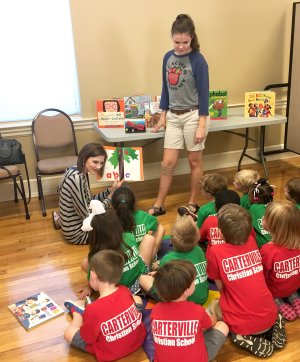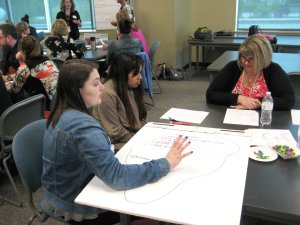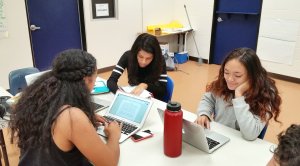Teacher Recruitment Starting in High School
From Mississippi to Hawaii, new programs recruit high school students to become teachers.
Your content has been saved!
Go to My Saved Content.“Don’t come back here like I did,” a middle school teacher once told me. “Go out and do something special.”
That educator was sending the signal to an impressionable kid that teaching is a stale gig, not a higher calling. It’s a shame because America needs more teachers, and young people will be needed to fill an increasing number of open positions, particularly in districts serving minority and low-income students.
Between 2009 and 2014, enrollment in teacher training programs dropped 35 percent, , which went on to reveal that 8 percent of the teacher workforce quits annually. Complaints about pay and working conditions are the most common explanations among teachers, but many cite a lack of administrative support, flawed accountability systems, and the drudgery of paperwork and testing.
But with the teacher pipeline dwindling, some school systems are tackling the issue head-on, reaching out to candidates they know they have to work hard to convince: high school students.
Part of the solution to teacher shortages and problems in education is to engage altruistic young people early.
Known as teacher learner academies, these programs give high schoolers experience in the classroom in hopes of identifying, inspiring, and preparing great teachers before they move on to college. Most are tailored to the needs of the communities they serve, which can mean instilling cultural pride in future teachers or building a diverse workforce that truly reflects student demographics. It’s worth noting that .
“There are kids who have always dreamed of teaching, and then there are kids who start out just wanting to make a difference,” says Dan Brown, former co-director of , a national organization that supports more than 2,400 schools with high school programs dedicated to helping students learn about teaching. “Part of the solution to teacher shortages and problems in education is to engage altruistic young people early.”
Giving Teaching a Test Drive
I didn’t heed that long-retired teacher’s advice back in middle school, and eventually became a high school English teacher. I don’t regret it.
over the percentage of teachers who quit within their first five years in the classroom, I saw many of my graduate school classmates leave the profession quickly. A number dropped out before they could even be hired—others needed only a year or two to feel too overwhelmed to continue.
Teaching isn’t a ‘sexy’ career, and there’s very little about it that overtly appeals to high school students. My program doesn’t have the latest gadgets, power tools, or a commercial kitchen. My students don’t get to drive tractors or fly drones over sporting events.
To address that issue, teacher academies aim to give students with an early interest in teaching a test-drive that can help them decide if teaching is a good fit.
“It’s sad, but many preservice teachers don’t spend extended time in classrooms until they do their student teaching. If they realize that the classroom may not be an ideal fit, what do they do? It’s too late to change majors,” explains Deidra Gammill, who has runs the Educators Rising–affiliated program at Petal High School in Petal, Mississippi.

In the program’s first year, Petal High students study the steps required to obtain a teaching certificate to understand the commitment, and interview their own teachers about their experiences. In the second year, students plan units and observe teachers at area elementary and middle schools. Through coursework, students learn about growth and fixed mindset, brain-based learning research, and the importance of cultivating reflective dispositions in young learners.
These grounding experiences help prospective teachers make an an informed decision before paying money for a teaching degree, reducing the likelihood that they’ll quit teaching early on, says Gammill. If a student doesn’t continue into the second year, Gammill still considers the program successful because it helped a student determine teaching wasn’t for them.
“Teaching isn’t a ‘sexy’ career, [and] there’s very little about it that overtly appeals to high school students. My program doesn’t have the latest gadgets, power tools, or a commercial kitchen. My students don’t get to drive tractors or fly drones over sporting events,” Gammill said. “So when I promote the Teacher Academy [to students], I focus on leadership and soft skills as what sets it apart.”
Community Connections
Other teacher academies believe that educators will be more likely to stick around if they develop deep ties to the school community. These programs seek high school students who have strong ties to an area and experiences that could foster connections with their future students.
Authorized and funded since 2007 by Washington’s state legislature, (RWT), for example, partners with high schools and universities to create a pathway between high school classes and a teaching certificate. The goal is not only to mold students into excellent teachers, but to encourage more young people of color to join the profession.

“We delve into cultural competencies and discover the impact that culturally responsive teaching can bring to a community,” explains Carla Smith, the teacher academy coordinator for Renton High School in Renton, Washington, a 10-year-old RWT site where over two-thirds of the student population is black, Asian, or Latino.
The RWT curriculum tasks students with examining their own identities first and then studying why inequalities exist in education. Considering that RWT sites crop up in areas of high need, participants typically have relevant firsthand experience to share. After they build a theoretical foundation to inform their eventual practice, students observe, reflect, and finally intern at area schools—closing the loop on a program that binds them deeply to their local communities.
Similarly, a new program in Hawaii, the Teaching and Learning Academy Program, aims to generate a homegrown workforce of teachers to establish more educational continuity at Hawaiian schools. Teacher attrition rates are especially bad in Hawaii, where only about half of the state’s public school teachers remain teaching after five years.
“Teaching has lost its luster here,” explains Camille Hampton, the program’s education pathway coordinator, who attributes the sentiment partially to the high cost of living. “A lot of students who want to work in communities don’t know if they see themselves as teachers. They’re told by counselors they should ‘do something better.’ We’re trying to help them see this as a real career path.”
Participating students typically have backgrounds that are similar to the students they encounter as teachers. At Waiʻanae High School, one of the program sites, nearly 95 percent of students are people of color—60 percent of those are Native Hawaiian—and roughly 70 percent of all students qualify for free or reduced-price lunch. A number will be first-generation college students.

These challenges are viewed as assets by program leaders, who believe the program will help fortify a commitment from future teachers to their future students. Along with training in field research, public speaking, sociology, and psychology, the curriculum includes courses on Hawaiian cultural heritage and modern politics to deepen students’ sense of place. Students who successfully complete the program receive a small monetary bonus or college course credit that can shorten the time it takes to get a teaching certificate.
A Long-Term Solution?
It’s still uncertain how successful these programs are at increasing the teacher pipeline.
Gamill’s academy is just 3 years old. Hawaii’s Teaching and Learning Academy Program won’t send a new teacher into the workforce for years. Even a venerable program like RWT has no formal tracking system and currently relies on anecdotal evidence, or on teachers who keep in touch with alumni.
According to Carla Smith, her high school has produced three elementary school teachers and one para-educator in the last decade, all of whom work in Renton schools, which represents a meaningful contribution to the local district.
They need fantastic teachers to guide them through the early challenges that could derail their careers before they become really good.
One of those teachers, Alex Castro-Wilson of Benson Hill Elementary, says that his return to the district sends a powerful message to the elementary school children he teaches.
“Students love that it could be them [teaching] one day,” says Castro-Wilson, adding that he needed the program for that inspiration himself. “I can honestly say that if it wasn’t for my high school teaching academy, I wouldn’t be where I am today. I was homeless for two years of my high school career and didn’t think I was smart enough for college.”
While such testimonials feel convincing, teacher learning academies—which continue to grow—can’t yet supply quantitative evidence that they’re expanding the teacher workforce in high-need areas.
And even if teacher academies can get more students into teaching, it is probably not enough to maintain a healthy teacher workforce, says Ellen Moir, the founder and CEO of the New Teacher Center, a 29-year-old organization dedicated to improving the effectiveness of teachers. Moir says that teachers leave the profession when they feel unsupported and frustrated by dwindling resources and scant leadership opportunities. Retaining existing teachers, she believes, is at least as important as inspiring new ones, if not more so.
“These programs can help young people see the future, but they are not an antidote to shortages,” says Moir of teacher learning academies. New teachers “can feel prepared when they’re with a master teacher, but when they get the keys to their own classrooms, they realize they’re not ready. They need fantastic teachers to guide them through the early challenges that could derail their careers before they become really good.”
